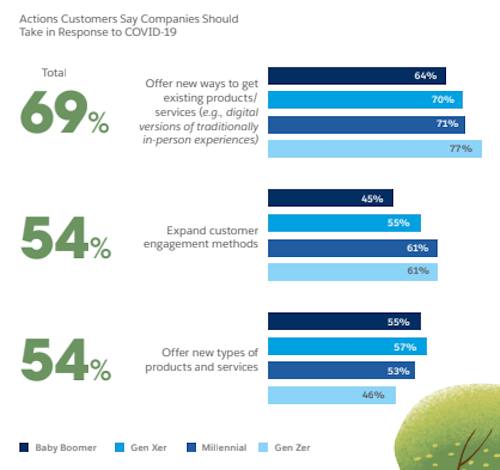Consumer behaviours and expectations are rapidly shifting the business landscape, so how can you capitalise on them online?
Our annual State of the Connected Customer Report (4th edition) gathered insights from over 15,000 global consumers and business buyers.
The global survey responses reveal:
How consumer behaviours and expectations are changing during crises.
The criteria customers use to assess brands in an online environment.
How the shift to digital channels will affect long-term customer engagement.
Why and how customers are holding companies accountable in new ways.
The report gives us a view of both global consumers and business buyers in a world that has been shaken up by several crises this year.
Below, we explain how businesses that adapt to these emerging trends will be more prepared in the New Normal.
Consumer behaviours and expectations in a new landscape
In an uncertain economic global landscape, consumer behaviours and expectations are shifting as brands move online. To succeed during this unprecedented time, businesses must work to build long-term customer connections.
Companies fall significantly short of customer expectations
Expectation: 68% of customers expect brands to demonstrate empathy.
Expectation: 66% of customers expect companies to understand their unique needs and expectations.
Reality: 37% of customers say brands generally demonstrate empathy.
Reality: 34% of companies generally treat customers as unique individuals.
We need to listen to our customers to meet their expectations. But how do we find out what those expectations are? Your customer base is likely to be very broad and there’s often a difference in generational behaviours and expectations. This is especially true in an online environment. Luckily, there are a number of ways to track and manage real-time consumer experiences.
Taking action to meet customer’s digital expectations
Whichever generation your customers are, their expectations are now more digitally driven than ever. Due to the pandemic, we wanted to find out what actions customers think businesses should be taking as the economic landscape begins to settle.
We can see from the report that the older generations are more concerned about companies offering completely new types of products and services. Conversely, the younger generations want to be able to access existing offerings through digital channels.
As we can see, it’s important to ensure digital considerations are planned before even bringing new products and services to market.
In terms of B2B expectations, it’s not surprising that most business buyers (85%) expect sales reps to show they clearly understand the buyer’s business, but 57% also say reps lack that knowledge.
Whatever the generation of your B2B customers, build trust by offering tailored solutions based on a demonstrated understanding of a business’s unique challenges and goals.
“84% of business buyers are more likely to buy from a company that demonstrates an understanding of their business goals.”
Connected customer experiences should be a priority
Many consumer behaviours are based on the experience they have with a company. And while the majority expect their experiences with different departments to be consistent (76%), it’s not always the reality.
Over half say they don’t think information is shared across different departments. And it feels like they’re dealing with completely separate units rather than one business.
This is common across the generations. In fact, 65% of customers agree with the statement, “I often have to repeat or re-explain information to different representatives.”
The survey demographics that agree with the statement above:
56% Gen Z
67% Millennials and Gen X
65% Baby Boomers
There isn’t much difference between Millennials, Gen Xers, and Baby Boomers, but Gen Z is less likely to have that issue. As the first true digital natives, perhaps they’re used to doing everything digitally and find it a smoother experience than speaking to different departments?
Understanding your customers’ needs
While consumer behaviours and expectations don’t always differ between generations, many do. It’s important to consider all generations of customers with their individual needs and expectations.
The full breakdown of consumer behaviours and expectations can be found in the State of the Connected Customer Report (4th edition).





